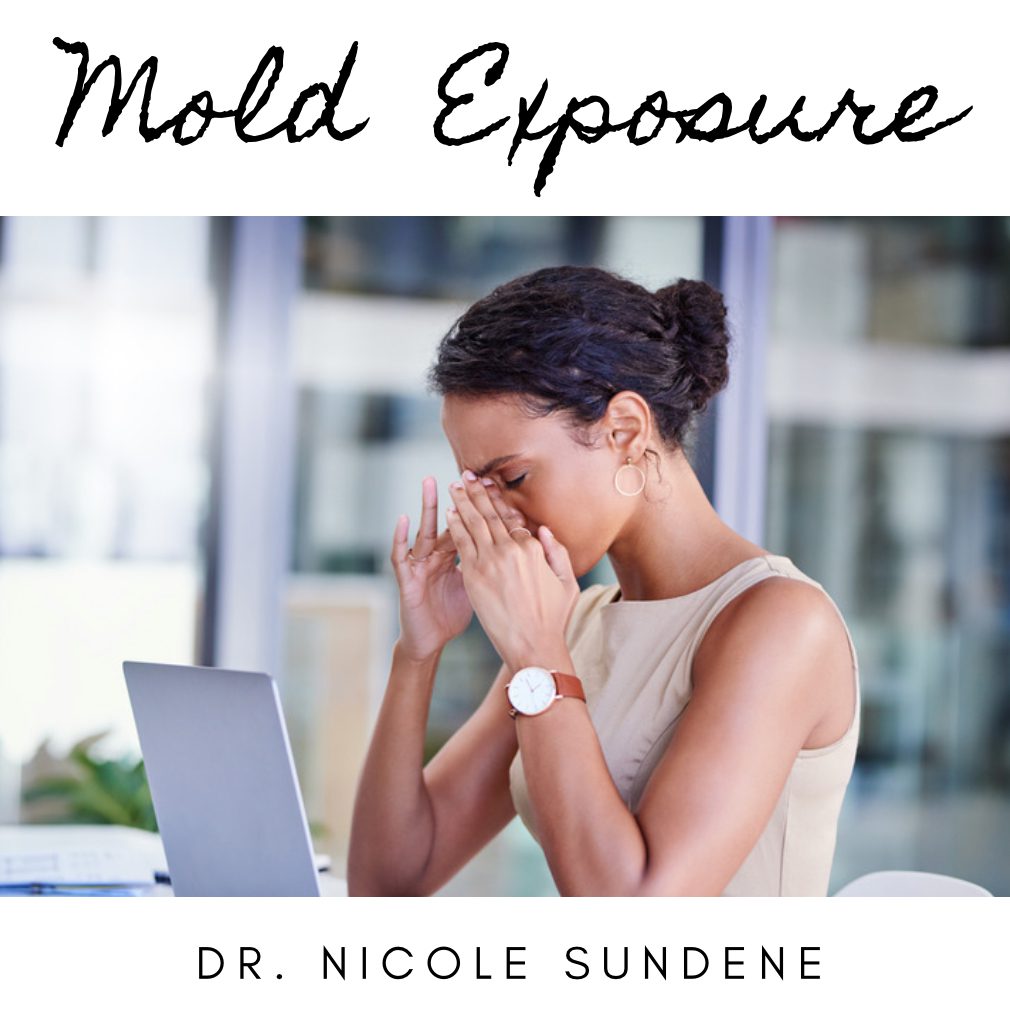
Dr. Nicole Sundene, NMD
Scottsdale Naturopathic Doctor
"Why did mold make me sick and my husband was fine? Are women more susceptible to mold because of our women's hormones?" Julia Paradise Valley, AZ
Mold exposure can impact women more than men because men have more testosterone so their body's generally run at a temperature that is higher than ours. Therefore women with a lower body temperature in the 97 range are the perfect Petri dishes to make mold! I know horrifying, right?
I get asked this question a lot because the majority of my mold patients are women and I often hear the same tale where they found mold in their house and it affected them but not their husband. Men will naturally have an easier time burning mold out of their system thanks to their high hormone levels!
Mold exposure can also more easily result in overgrowth in the body when the patient has low body temperature from hypothyroidism, blood pressure or cardiovascular issues.
Mold exposure testing of the individual and the home is very important in Arizona as the first layer or our desert is mainly mold, and our temperature generally is perfect to host mold that never gets fully killed off.
Leaks in the home can quickly create a moldy environment due to warm temperatures that favor the growth of mold. Sometimes my patients never even know how they were exposed to mold, it could have happened at a hotel or foreign travel, it doesn't always have to happen in your home. However, if you are experiencing leaks or mold in your home, you should get not just the home tested, but a test for yourself as well.
Mold testing is expsecially important when the patient is experiencing the following common cluster of symptoms related to mold exposure. Generally my typical mold patient will tell a tale of being perfectly healthy and then suddenly feeling sick and tired all the time. Although some have been sickly for unknown reasons since they were babies.
Natural medicine, herbs, supplements, hormone balancing, binders, and antifungal medications together can help get your life back after mold exposure. While it does require a bit of work, today I want to go over the symptoms of mold, mold testing, the different types of mold and mildew, as well as how to prevent their formation around your home. The #1 most important thing I want you to know as a Women's Health Naturopathic Doctor that treats a lot of mold exposure patients and women with chronic yeast infections, is that a Mycotox test helps me understand what treatment we need to do the fastest, helps my patients adhere to their treatment when they see a positive tested, and is highly recommended for patients with the following mold symptoms:
SYMPTOMS OF BLACK MOLD EXPOSURE OR OTHER MOLD EXPOSURE
Other diseases and symptoms linked to mold exposure are Fever, autoimmune disease, depression, ADHD, liver damage, anxiety, heart disease, palpitations, autism and ASD.
Patients with symptoms related to mold exposure should identify and treat the cause of the exposure which is generally environmental although it is possible for fungus to take root in the body in the lungs, digestive tract, kidneys, and sinus and begin to propagate. In this case, the patient must be treated with prescription or botanical antifungals, or the symptoms from the mold exposure will never resolve or may take years to resolve.
MOLD EXPOSURE TESTING FOR PATIENTS
Mold testing or “Mycotox testing” is not covered by insurance. This alternative test looks at the patient's urine to identify the type of mold or fungus causing the patient's sickness. This is especially helpful when previous treatments have not worked, the patient is extremely ill, and/or just wants to get better as fast s possible.
Mold treatment should be done by an experienced naturopathic doctor and involves first testing the patient for the presence of mycotoxins, and identifying the source of the exposure to the mycotoxins via environmental and home mold testing. We then treat the patient with botanical or prescription antifungals depending on if the exposure is internal or external.
MOLD EXPOSURE TREATMENT
Patients testing positive for mold should do regular saunas and sweating to eliminate the mold and use supportive herbal medicine and nutrition. Adhere to a low-carb diet and eliminate foods that contain yeast and mold as well as consume binders such as clay and activated charcoal to help pull the mold and mycotoxins out of the system. Generally, a lifelong allergy to molds and yeasts happens after a significant exposure, especially to black mold.
MOLD EXPOSURE FROM YOUR HOME
If you are fatigued, with a chronic itchy nose, you may be reacting to hidden sources of mold in your home. Generally speaking, mold proliferates in dark, damp areas.
Older homes, and homes without ample sunlight will typically generate more mold.
If your entire family is constantly sick or sick with allergies, hire someone to test for mold and clean it up.
Here are five common hidden household sources of mold:
Although mold may be proliferating in other areas of your home, be sure to stay on top of the most common mold producing areas that we all interact with. Many people with allergies will improve just from these simple tips.
In naturopathic medicine, we address the “total load” of allergies. Food allergies, food sensitivities, and allergies to mold, will almost always worsen seasonal allergies. The less your immune system is required to react to, the healthier and less symptomatic you should ultimately be. Once patients have been exposed to mold they generally have a lifelong allergy to mold and yeast.
For those with severe allergies and respiratory problems, I would recommend the use of a HEPA air filtration system to further fight the war on mold and other household allergens.
WHAT IS MOLD OR MILDEW?
Molds are a diverse group of fungi. Under optimal conditions, with organic matter and water, a single mold spore can germinate and produce a fungal colony with hundreds of thousands of spores in 4 to 9 days. Fungi thrive in the 65% to 85% humidity ranges, though most allergenic molds release their spores during dry conditions of humidity below 70%.
HOW LONG DO MOLD EXPOSURE SYMPTOMS LAST?
People who are allergic to molds may have symptoms that persist for long periods of time, recur several times throughout the year, or are associated with specific environments where molds flourish. Molds are so widespread in nature that total avoidance is quite difficult. There are, however, a number of precautions that can help limit your exposure.
MOLD EXPOSURE INDOORS
Mildew, for example, is the common name for some of the more common molds that grow rapidly inside the home. Areas where mold flourishes include shower stalls, spoiling food, draperies, wallpaper, and its canvas backing, luggage, shoes, gloves, leather goods, damp linens or clothing, and locations where flooding has occurred, especially around leaky toilets, sinks, ceilings, refrigerators or dishwashers. Wood floors, baseboards, closed-up cabins or boats, poorly circulated storage areas, refrigerator drip pans, air conditioners, or dehumidifier reservoirs are other common mold sites. Anywhere dust or soil accumulates in the home is likely to provide a suitable area for mold growth. Stuffed furniture, pillows, mattresses, old stuffed toys, wool carpets, stored paper products, stored clothing, and bedding are likely to grow mold. Aquariums and indoor plants can also attract mold growth in the home.
MOLD EXPOSURE PREVENTION
Efforts should be made to create at least one allergen-free room in the home. Generally, it should be a bedroom where the mold-sensitive person can spend as much time each day as possible. It is particularly important that furniture covers be made of vinyl or synthetic material. Upholstered furniture, down comforters, stuffed toys, carpeting, and wall hangings should be removed. Hardwood, vinyl, or tile floors are suggested. Dust and soil should be frequently removed with a HEPA vacuum or a wet mop. Air filtration devices and dehumidifiers can help. Central air conditioning and heating generally generate less dampness in the home, as long as filters are cleaned regularly. Mold-resistant paints should be used in this room and throughout the home. A small electric light in poorly ventilated areas will help reduce humidity.
There are no safe, long-lasting fungicides for use within the home. Common germicides (Lysol, Tylex) can help kill many indoor molds. Ordinary bleach at 50% to full strength can kill molds (in areas where it won’t destroy furnishings or paint). In severe cases, ozone generators can be used to kill indoor mold during periods while the home is vacant.
MOLD EXPOSURE OUTDOORS
Avoiding windy days outdoors is the #1 most important factor for patients suffering from mold exposure or mold allergy. Molds play an important role in the decomposition of organic matter, helping to return vital nutrients to the soil. Because of this factor, mold-sensitive individuals should avoid contact with decomposing leaves, grasses, and grains. Check your yard and surroundings for any decomposing plants or trees and have them removed as this is generating more mold spores in the air around your home.
This includes activities such as raking or mowing lawns, handling or harvesting grain, and working around haystacks and feed barns. Travel in rural areas, especially on dry, windy days during or after a harvest should be avoided. Dense vegetation around living and working quarters should be cleared. If exposure to molds cannot be avoided, a facemask should be worn to filter the airborne allergens. Fungicides can be used sparingly outside the home with the expertise of an organic landscaper.
If you need my help testing for mold exposure or treating for mold exposure I would be happy to help. The Moldex test is a simple urine test that helps us understand the strain of mold or yeast the patient has been exposed to. If you would like to perform the test prior to coming into the clinic simply call ahead and allow five full weeks for your Mold test to come back before booking your new patient visit over on my SCHEDULE page.
Dr. Nicole Sundene
(480) 837-0900
Dr. Sundene is a Naturopathic Doctor in Scottsdale, Arizona, and is a Female Hormone Expert in Women's Health and Bioidentical Hormones. She specializes in Holistic Women's Health for Menopause, Thyroid, Hashimotos, PMS, Perimenopause, Autoimmune, Postpartum, Chronic Fatigue, Depression, Anxiety, Food Allergies, Digestion, Dermatology, Acne, Psoriasis, Eczema, and Adrenal Hormonal Conditions. In 1999 she began working for a Hormone Doctor prior to starting Naturopathic Medical School. With over 23 years of experience in both Prescription and Natural women's health and hormones, she presents to women the best-integrated health solutions for their Chronic Disease.
She has been an Herbalist for over 28 years and enjoys teaching women how to use herbs to balance their hormones, nutrition and optimize their health. Dr. Sundene relies on blood testing for her hormone metrics. The hormone testing is covered per the patient's insurance plan (not Medicaid) and conducted at certain points in the woman's menstrual cycle. To learn more about Hormone Testing for Women Visit: Bioidentical Hormones. Follow Dr. Sundene on Instagram, Twitter, and Facebook for more tips on Women's Health, Female Hormones, and Naturopathy!


